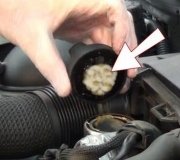2000 Dodge Dakota 6 cyl Two Wheel Drive Automatic
Well, been working on this v6 2000 3.9 l Dakota that my brother said overheated and started blowing white smoke. I have the heads off and wanted to make some comments and get some advice:
1: This is the first time I have worked on a dodge. I thought the distributor would need to come out in order to take the intake off. I took off the mounting clamp for the distributor. I made a mark with a sharpie on the "plate" that is on top of the distributor base below the rotor. I made the mark in the direction the rotor was pointing. (The best I could, it was hard to see back there.) I actually never took the distributor out. When putting this back together, can I just aline the rotor with this mark. If it is off a 1/4 inch will it matter or do I need to do something different?
2: I took all head bolts out and pushrods and punched holes in two shoeboxes to store them to keep them in order. How do I tell if the head bolts need replaced? Also, the push rods had a clack coating on them. DO they need to be cleaned? Also, an old manual to another car said to put grease on the top of the pushrod the area the rocker arm contacts. Is this good advice or will it block oil flow?
3. The back piston where I had high compression and was blowing coolant out the spark plug hole was about two inches from the top. I felt around and used a mirror and did not see anything wrong. Should I turn the engine over so I can inspect the rest of the bore? Will this disturb timing?
4: On this same piston there are two areas where a small "glob" of metal apparently attached to the piston. In this same cylinder during disassembly, the spark plug gap arm was missing. They are about the size of a baby asprin. I could not pry them loose with my finger. Should I try a razor blade? Is this really bad?
5: I am not sure if I am looking for is right but the head gasket looked alright to me. There were no "blown out" areas where gasket material was missing between cylinders or anything. Does this mean it might not be the head gasket?
6: Lastly, I am going to have a shop mill and crack check the heads. If they hot tank them, will this mess up the valve seals? Should I have them replaced? This engine has about 151,000 and ran ok when disassembled other than the overhweatign and smoke assumed from a leaking head gasket and anti freeze in the intake. I may drive this truck if it runs or sell it, not sure.
7: Oh, one last thing, some "leaf" material fell into the engine when I took the intake off. I vacuumed it as much as I could but did not get it perfect. Will this be a problem?
As always I appreciate your help!
SPONSORED LINKS
Monday, April 13th, 2009 AT 7:48 AM



